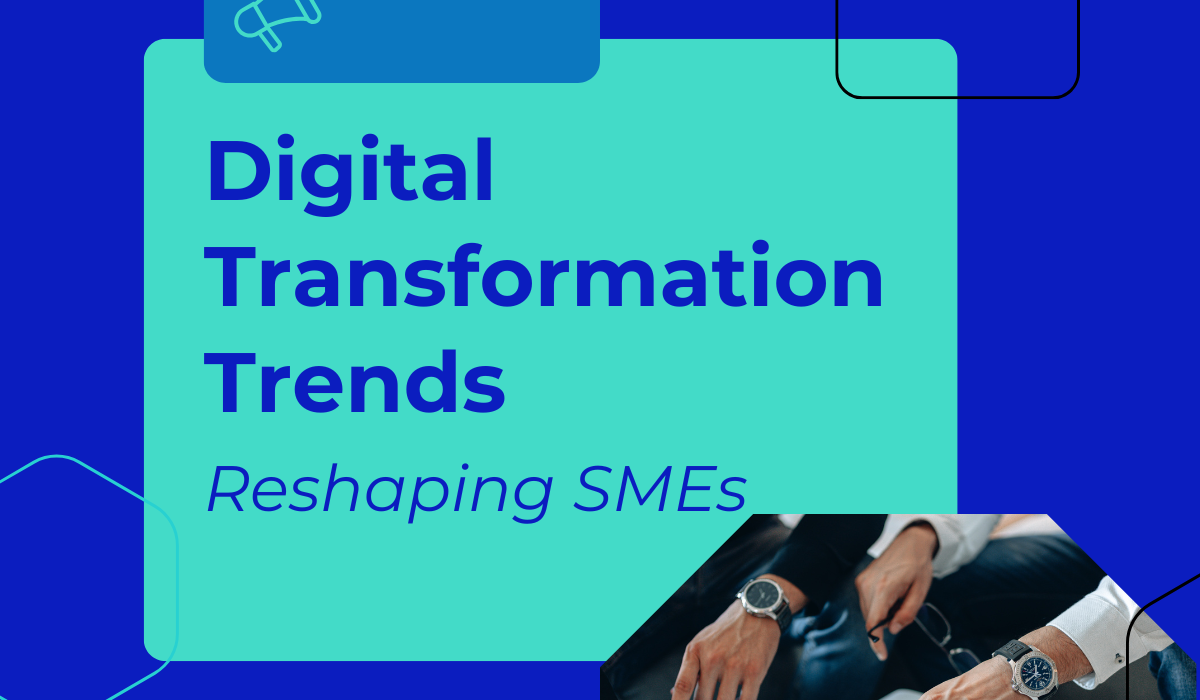10 Digital Transformation Trends Reshaping SMEs in 2025

The digital revolution is in full swing, and Small to Medium Enterprises (SMEs) are not immune to its transformative power. To stay competitive and thrive in 2025 and beyond, embracing digital transformation is no longer optional – it’s essential. This means more than just having a website; it’s about integrating technology into every facet of your business to optimise operations, enhance customer experiences, and unlock new growth opportunities. Here are 10 digital transformation trends reshaping SMEs in 2025:
1. Hyperautomation & AI Integration:
Automation is becoming increasingly sophisticated, with Artificial Intelligence (AI) playing a central role. SMEs are leveraging AI-powered tools for tasks like:
- Customer service: Chatbots and virtual assistants provide instant support and personalised recommendations. According to a recent study by Juniper Research, chatbots are expected to save businesses over $2.5 billion in customer service costs.
- Marketing: AI-driven analytics help personalize campaigns, optimize ad spending, and predict customer behavior. 76% of marketers using AI and machine learning in their marketing strategies achieved revenue growth in 2022. [Source: Salesforce]
- Operations: Streamlining workflows, automating data entry, and optimizing supply chain management. McKinsey reports that AI-powered supply chain management can reduce costs by up to 20% and increase revenue by up to 10%.
Tools to consider: Zapier, HubSpot
2. The Rise of the Metaverse:
The metaverse is no longer a futuristic concept; it’s rapidly becoming a reality. For SMEs, the metaverse offers exciting opportunities to:
- Create immersive brand experiences: Engage customers with virtual storefronts, product demonstrations, and interactive events.
- Expand market reach: Connect with a global audience in virtual environments.
- Explore new revenue streams: Offer virtual products, services, and experiences.
3. Advanced Data Analytics & Business Intelligence:
Data is the new gold, and SMEs are realising its value. By leveraging advanced analytics and business intelligence tools, they can:
- Gain deeper customer insights: Understand customer preferences, behaviors, and needs.
- Make informed decisions: Track key performance indicators (KPIs), identify trends, and make data-driven decisions.
- Improve operational efficiency: Identify bottlenecks, optimize processes, and improve resource allocation.
Tool to consider: Google Analytics
4. Cybersecurity: A Top Priority:
With the increasing reliance on technology, cybersecurity threats are becoming more sophisticated. SMEs need to prioritize:
- Data protection: Implement robust security measures to protect sensitive customer data and prevent breaches. The average cost of a data breach for SMEs is $120,000.
- Employee training: Educate employees about cybersecurity best practices and potential threats. Human error is a contributing factor in 95% of cybersecurity breaches. Source: CybSafe]
- Proactive threat detection: Invest in security solutions that can detect and respond to threats in real-time.
Solutions to explore: Cloudflare, Norton, Bitdefender
5. The Everywhere Workplace:
The traditional office is evolving. SMEs are embracing remote and hybrid work models, enabling them to:
- Access a wider talent pool: Recruit employees from anywhere in the world.
- Increase employee satisfaction: Offer flexibility and work-life balance. A study by Owl Labs found that 83% of employees prefer a hybrid work model. Australia’s working dynamic has evolved into three ways of working: workplace, remote and hybrid. Hybrid work has gained popularity in recent years since COVID-19 and is now the most likely scenario for Aussie workers with 45% of Australians working in this format.
- Reduce overhead costs: Minimise office space and associated expenses.
Tools to facilitate: Slack, Microsoft Teams, Zoom
6. Sustainable Tech for a Greener Future:
Sustainability is becoming a key concern for consumers and businesses alike. SMEs are adopting technology to:
- Reduce environmental impact: Optimise energy consumption, minimise waste, and implement sustainable practices. 73% of consumers are willing to pay more for sustainable products.
- Enhance brand reputation: Attract environmentally conscious customers and improve brand image.
- Meet regulatory requirements: Comply with environmental regulations and avoid penalties.
7. Personalised Customer Experiences:
Customers expect personalised experiences tailored to their individual needs and preferences. SMEs are leveraging data and AI to:
- Provide personalised recommendations: Suggest products and services based on customer browsing history and purchase behavior. According to McKinsey, personalised recommendations can increase sales by up to 25%.
- Offer targeted promotions: Deliver personalised offers and discounts based on customer segments.
- Create customised content: Tailor marketing messages and website content to individual customer needs.
8. Low-Code/No-Code Platforms:
The demand for software solutions is increasing, but not all SMEs have the resources to hire dedicated developers. Low-code/no-code platforms empower businesses to:
- Build custom applications: Develop software solutions without extensive coding knowledge.
- Accelerate digital transformation: Implement new technologies and automate processes faster.
- Empower citizen developers: Enable non-technical employees to create and customize applications.
9. 5G and Enhanced Connectivity:
The rollout of 5G technology is transforming connectivity, offering SMEs:
- Faster internet speeds: Improve communication, collaboration, and data transfer speeds.
- Increased bandwidth: Support the growing number of connected devices and applications.
- New opportunities for innovation: Develop new products and services that leverage 5G capabilities.
10. Blockchain Technology:
Beyond cryptocurrencies, blockchain technology is finding applications in various industries. SMEs can leverage blockchain to:
- Improve supply chain transparency: Track products and materials throughout the supply chain.
- Enhance security: Secure transactions and protect sensitive data.
- Build trust with customers: Increase transparency and accountability in business operations.
This is more than just adopting new tech – it’s about embracing change. It’s about adopting a new mindset, transforming your processes, and evolving a supportive culture. We understand that change can be challenging, but it’s also essential for growth.
CPC will guide you through every step of your transformation journey, providing the timely support, change expertise, and strategic guidance you need to navigate change successfully. Book your free consultation today.

